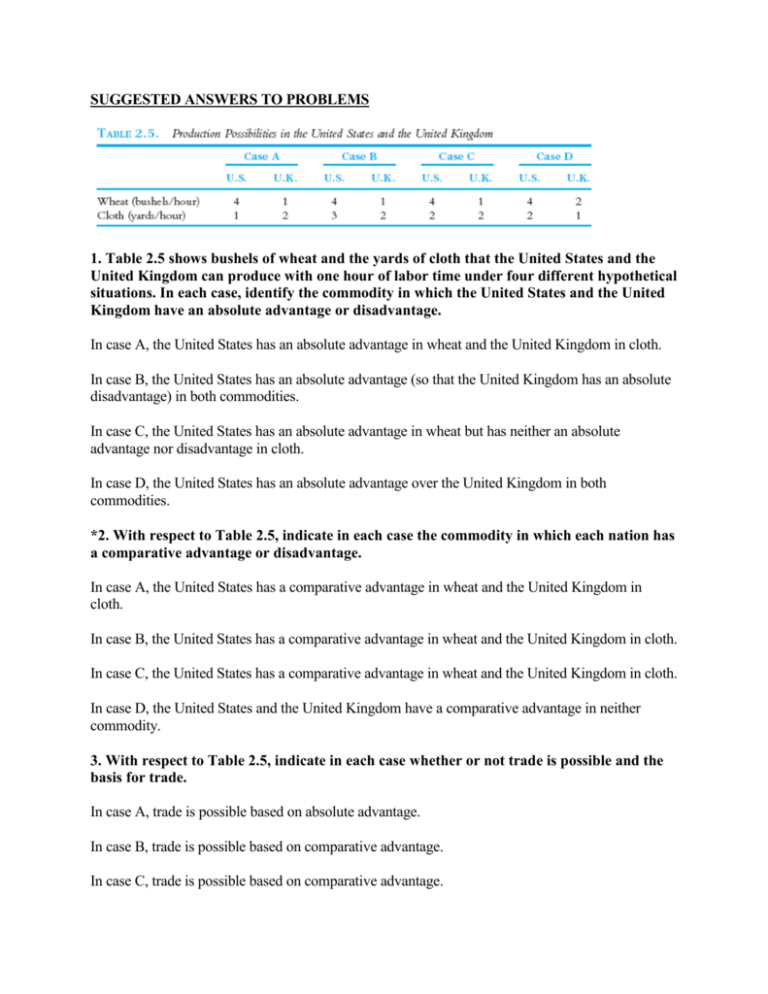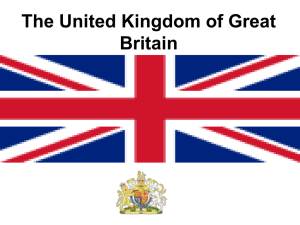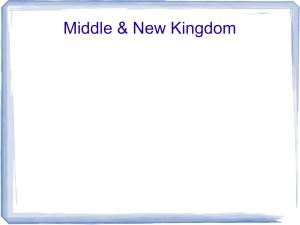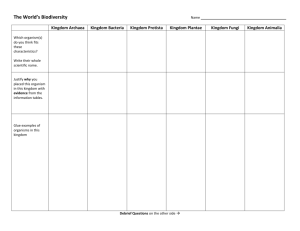Chapter 2 Book Answers
advertisement

SUGGESTED ANSWERS TO PROBLEMS 1. Table 2.5 shows bushels of wheat and the yards of cloth that the United States and the United Kingdom can produce with one hour of labor time under four different hypothetical situations. In each case, identify the commodity in which the United States and the United Kingdom have an absolute advantage or disadvantage. In case A, the United States has an absolute advantage in wheat and the United Kingdom in cloth. In case B, the United States has an absolute advantage (so that the United Kingdom has an absolute disadvantage) in both commodities. In case C, the United States has an absolute advantage in wheat but has neither an absolute advantage nor disadvantage in cloth. In case D, the United States has an absolute advantage over the United Kingdom in both commodities. *2. With respect to Table 2.5, indicate in each case the commodity in which each nation has a comparative advantage or disadvantage. In case A, the United States has a comparative advantage in wheat and the United Kingdom in cloth. In case B, the United States has a comparative advantage in wheat and the United Kingdom in cloth. In case C, the United States has a comparative advantage in wheat and the United Kingdom in cloth. In case D, the United States and the United Kingdom have a comparative advantage in neither commodity. 3. With respect to Table 2.5, indicate in each case whether or not trade is possible and the basis for trade. In case A, trade is possible based on absolute advantage. In case B, trade is possible based on comparative advantage. In case C, trade is possible based on comparative advantage. In case D, no trade is possible because the absolute advantage that the United States has over the United Kingdom is the same in both commodities. *4. Suppose that in Case B in Table 2.5 the United States exchanges 4W for 4C with the United Kingdom. (a) How much does the United States gain in terms of cloth? (b) How much does the United Kingdom gain in terms of cloth? (c) What is the range for mutually beneficial trade? (d) How much would each nation gain if they exchanged 4W for 6C instead? a) The United States gains 1C. b) The United Kingdom gains 4C. c) 3C < 4W < 8C. d) The United States would gain 3C while the United Kingdom would gain 2C. 5. Use the information for Case B in Table 2.5 and assume that labor is the only factor of production and is homogeneous (i.e., all of one type). (a) What is the cost in terms of labor content of producing wheat and cloth in the United States and the United Kingdom? (b) What is the dollar price of wheat and cloth in the United States if the wage rate is $6? (c) What is the pound price of wheat and cloth in the United Kingdom if the wage rate is £1? a) The cost in terms of labor content of producing wheat is 1/4 in the United States and 1 in the United Kingdom, while the cost in terms of labor content of producing cloth is 1/3 in the United States and 1/2 in the United Kingdom. b) In the United States, Pw=$1.50 and Pc=$2.00. c) In the United Kingdom, Pw=£1.00 and Pc=£0.50. 6. Answer the following questions with reference to Problem 5. (a) What is the dollar price of wheat and cloth in the United Kingdom if the exchange rate between the pound and the dollar is £1 = $2? Would the United States be able to export wheat to the United Kingdom at this exchange rate? Would the United Kingdom be able to export cloth to the United States at this exchange rate? (b) What if the exchange rate between the dollar and the pound were £1 = $4? (c) What is the exchange rate were £1 = $1? (d) What is the range of exchange rates that will allow the United States to export wheat to the United Kingdom and the United Kingdom to export cloth to the United States? a) With the exchange rate of £1=$2, Pw=2.00 and Pc=$1.00 in the United Kingdom, so that the United States would be able to export wheat to the United Kingdom and the United Kingdom would be able to export cloth to the United States. b) With the exchange rate of £1=$4, Pw=$4.00 and Pc=$2.00 in the United Kingdom, so that the United States would be able to export wheat to the United Kingdom, but the United Kingdom would be unable to export any cloth to the United States. c) With £1=$1, Pw=$1.00 and Pc=$0.50 in the United Kingdom, so that the United Kingdom would be able to export both commodities to the United States. d) $1.50 < £1.00 < $4.00 7. Assume that the data in Case B in Table 2.5 refer to millions of bushels of wheat and millions of yards of cloth. (a) Plot on graph paper the production frontiers of the United States and the United Kingdom. (b) What is the relative price of wheat (i.e., PW/PC in the United States and in the United Kingdom in autarky (no trade)? (c) What is the relative price of cloth (i.e., PC/PW in the United States and in the United Kingdom in autarky? a) See Figure 1. b) In the United States Pw/Pc=3/4, while in the United Kingdom, Pw/Pc=2. c) In the United States Pc/Pw=4/3, while in the United Kingdom Pc/Pw=1/2. 8. Using the United States and United Kingdom production frontiers from Problem 7, assume that the no-trade or autarky point is 3W and 3/4C (in million units) in the United States and 1/2W and 1C in the United Kingdom. Also assume that with the opening of trade the United States exchanges 1W for 1C with the United Kingdom. Show graphically for the United States and the United Kingdom the autarky (or no-trade) point of production and consumption, the point of production and consumption with trade, and the gains from trade. See Figure 2. The autarky points are A and A' in the United States and the United Kingdom, respectively. The points of production with trade are B and B' in the United States and the United Kingdom, respectively. The points of consumption are E and E' in the United States and the United Kingdom, respectively. The gains from trade are shown by E > A for the U.S. and E' > A' for the U.K. 9. (a) What would be the equilibrium-relative commodity price of wheat if DW(US+UK) shifted up by one-third in the left panel of Figure 2.3? How much wheat and cloth would the United States and the United Kingdom then produce? (b) What does the answer to part (a) imply for DC(UK+US) in the right panel of Figure 2.3? a) If DW(US+UK) shifted up in Figure 2.3, the equilibrium relative commodity price of wheat would also rise by 1/3 to PW/PC=4/3. Since the higher DW(US+UK) would still intersect the vertical portion of the SW(US+UK) curve, the United States would continue to specialize completely in the production of wheat and produce 180W, while the United kingdom would continue to specialize completely in the production of cloth and produce 120C. b) Since the equilibrium relative commodity price of cloth is the inverse of the relative commodity price of wheat, if the latter rises to 4/3, then the former falls to ¾. This means that DC(UK+US) shifts down by 1/3 in the right panel of Figure 3. *10. What would happen if DW(US+UK) intersected the horizontal portion of SW(US+UK) at PW/PC = 2/3 and 120W in the left panel of Figure 2.3? What would this imply for specialization in production and the distribution in the gains from trade between the two nations? If DW(US+UK) intersected SW(US+UK) at PW/PC=2/3 and 120W in the left panel of Figure 2.3, this would mean that the United States would not be specializing completely in the production of wheat. The United Kingdom, on the other hand, would be specializing completely in the production of cloth and exchanging 20C for 30W with the United States. Since the United Kingdom trades at U.S. the pre-trade relative commodity price of PW/PC=2/3 in the United States, the United Kingdom receives all of the gains from trade. 11. Draw a figure similar to Figure 2.2 showing that the United Kingdom is now a small country, half the size shown in the right panel of Figure 2.2, and trades 20C for 30W with the United States at PW/PC = 2/3. See Figure 2.3 on page 15 and the discussion in the last paragraph of Section 2.6b in the text. 12. (a) How was the Ricardian trade model tested empirically? (b) In what way can the results be said to confirm the Ricardian model? (c) Why do we then need other trade models? a) The Ricardian model was tested empirically by showing the positive correlation between relative productivities and the ratio of U.S.to U.K. exports to third countries and by the negative correlation between relative unit labor costs and relative exports b) The Ricardian trade model was confirmed by the positive relationship found between the relative labor productivity and the ratio of U.S. to U.K. exports to third countries, as well as by the negative relationship between relative unit labor costs and relative exports. c) Even though the Ricardian model was more or less empirically confirmed we still need other models because the former assumes rather than explains comparative advantage (i.e., it does not explain the reason for the different labor productivities in different nations) and cannot say much regarding the effect of international trade on the earnings of factors of production. 13. How would you counter the argument that the United States needs to restrict textile imports in order to save American jobs? The United States has a comparative disadvantage in the production of textiles. Restricting textile imports would keep U.S. workers from eventually moving into industries in which the United States has a comparative advantage and in which wages are higher. *= Answer provided at www.wiley.com/college/salvatore. SUGGESTED ANSWER TO PROBLEM IN APPENDIX 2 The numbers in the following table refer to the cost or price of commodities X, Y, and Z in nations A, B, and C in terms of the same currency. Thus, nation A exports commodity X to nations B and C; nation B exports commodity Y to nations A and C; nation C exports commodity Z to nations A and B. Commodity X Y Z A 1 3 4 Nation B 2 1.5 3 C 3 2 2









